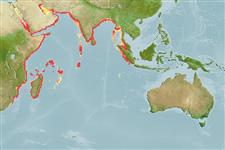Common names from other countries
Environment: milieu / climate zone / depth range / distribution range
Οικολογία
; Υφάλμυρο; εύρος βάθους 1 - 170 m (Ref. 8), usually 10 - 30 m (Ref. 8). Tropical, preferred 26°C (Ref. 107945); 30°N - 31°S, 29°E - 103°E
Indo-West Pacific and Southern Atlantic. Introduced in the Mediterranean. Tropical to subtropical.
Length at first maturity / Μέγεθος / Βάρος / Age
Maturity: Lm 12.7, range 11 - 12 cm Max length : 19.9 cm TL αρσενικό/απροσδιόριστο; (Ref. 119750); 22.6 cm TL (female); μεγ. αναφερόμενη ηλικία: 2.50 έτη (Ref. 104940)
Maximum carapace length: 5.0 cm (female; Ref. 8). Prefers bottom sandy mud (Ref. 8). Also occurs on seagrasses, mudflats, sandflats and mangrove channels. Frequently burrows (Ref. 106912). Feeds on crustaceans, polychaetes, mollusks, fishes, algae and detritus (Ref. 104916).
Mating behavior: Precopulatory courtship ritual is common (through olfactory and tactile cues); usually indirect sperm transfer (Ref. 833). Females spawn once every two (2) months (Ref. 104933).
Holthuis, L.B. 1980. (Ref. 8)
IUCN Red List Status (Ref. 130435)
CITES status (Ref. 108899)
Not Evaluated
Not Evaluated
Human uses
αλιεία: Εμπορικό(ά); δόλωμα: occasionally
FAO - αλιεία: landings | FishSource | Η θάλασσα γύρω μας
Εργαλεία
Διαδικτυακές πηγές
Estimates based on models
Preferred temperature
(Ref.
115969): 25.2 - 29.3, mean 27.8 (based on 258 cells).
Ελαστικότητα
Υψηλό, ελάχιστος χρόνος για διπλασιασμό πληθυσμού < 15 μήνες (K=0.67-2.2; tmax=2.5).
Prior r = 1.11, 95% CL = 0.74 - 1.67, Based on 2 data-limited stock assessments.
Vulnerability
Low vulnerability (10 of 100).
